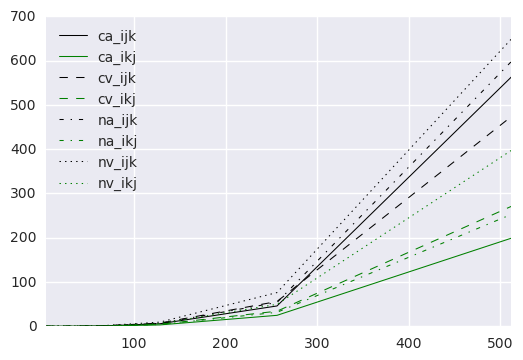In my last post (PHP-SDS First thoughts) I introduced the library PHP-SDS.
Today I’ll talk about some performance benchmarks that I’ve been doing in order to optimize the polyfill code.
The benchmark script has measured 8 different versions of the naive matrix multiplication algorithm:
- Using
arrayvs UsingDs\Vector. - Contiguous values vs Nested rows
I,J,Kiteration order vsI,K,Jiteration order.
I didn’t try to parallelize anything in any way, since PHP isn’t a well suited language to do this sort of things. I didn’t try to implement the Strassen algorithm neither, because first I want to have a solid baseline to compare (and because at some point, the Strassen algorithm should fallback to the naive algorithm).
Scripts used to benchmark and present data:
Expectations vs Reality
In the first place, I should explain what my expectations were before the experiment. I thought that the best
combination would be (Ds\Vector, contiguous values, I,K,J)…
But the reality didn’t match my expectations, the best combination was (array, contiguous values, I,K,J ).

Why I thought that Ds\Vector would offer better performance than array for matrix multiplications? The two main
reason were the smaller memory footprint, and the better performance of Ds\Vector on other operations.
I imagined that less memory usage would lead to less cache misses, but probably I missinterpreted WHY Ds\Vector
uses less memory than array. The reason was not that Ds\Vector uses less bytes per item, but that Ds\Vector uses a
“smarter”¹ algorithm to allocate memory regions in order to grow o shrink itself.
Why I,K,J runs faster than I,J,K?
Why my other two guesses were right? Well, it’s because the CPU cache.
- Using a single data structure we avoid one indirection per read, and we can take more advandatge of data locality.
- Traversing the matrix instances with the I,K,J order we ensure a row-by-row order (and even better, we can avoid some redundant read operations). This way we have a cache-oblivious algorithm.
Final thoughts
There are some benchmarks that I’d like to do in order to have a more precise image of what’s happening with Ds\Vector.
I’ll measure isolated offsetGet and offsetSet operations, and a combination of both (using += for example).
Returning to my beloved matrix… In a fantastic @nikic’s post (PHP’s new hastable implementation), we can see that packed PHP arrays consume ~32 bytes per item. The Matrix use-case is “good” enough¹ to allow us storing raw values without using wrappers.
Typically, long & double values take 8 bytes in 64 bit systems, so using a compiled extension we should be able to
divide the memory footprint by 4 (and store 4 times more items per cache line). If we allow less precision (using 32
bits instead of 64), then we can use less CPU time and memory.
See you soon!
Notes
- Because it can rely on some assumptions that aren’t true for
array.
